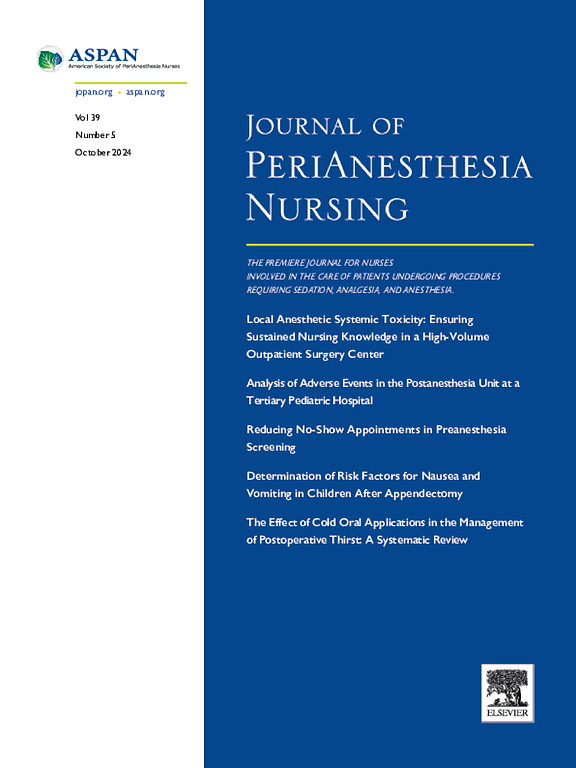A Retrospective Cohort Study Examining the Validation of the Modified Duke Activity Status Index in the Non-cardiac Surgical Population
IF 2
4区 医学
Q2 NURSING
引用次数: 0
Abstract
Purpose
We aimed to ascertain if the Duke Activity Status Index (DASI) and its simplified variants predict 30-day mortality and myocardial injury after major non-cardiac surgery in at-risk patients.
Design
Retrospective cohort study.
Methods
We included 4,199 patients to validate the DASI and its variants in predicting the same composite outcome in patients with risk factors for coronary artery disease. Additional outcomes included 30-day severe complications, 1-year survival, and the effect of the Area Deprivation Index (ADI) on the DASI score and subsequent outcomes.
Findings
Patients were a median of 66 years old (interquartile range 57.0, 73.0), 47.9% were male, predominantly Caucasian (71.9%), with an American Society of Anesthesiologists score of 3 or greater (80.7%) and a median National ADI of 54.0 (interquartile range 33.0 to 74.0). The 30-day composite outcome was predicted by the original DASI (area under the curve [AUC] 0.82 [CI 0.73, 0.91], P < .001); modified 4-question DASI (AUC 0.82 [CI 0.73, 0.91], P < .048). The original DASI also predicted the 1-year composite outcome (hazard ratio 0.88 [CI 0.84, 0.93], P < .001), as did the modified 4-question DASI (hazard ratio 0.78 [CI 0.69, 0.89], P < .001), but not severe complications (P = .400 and P = .332 respectively). The ADI showed an inverse relationship with all versions of the DASI; there was a 0.8-point DASI decrease ([95% confidence interval −0.96 to −0.59], P < .001) for every 10-point increase in the National ADI.
Conclusions
The DASI is a reliable predictor of long-term postoperative outcomes.
一项回顾性队列研究,检验改良杜克活动状态指数在非心脏手术人群中的有效性。
目的:我们旨在确定杜克活动状态指数(DASI)及其简化变体是否能预测高危患者在非心脏大手术后 30 天的死亡率和心肌损伤:设计:回顾性队列研究:我们纳入了 4,199 名患者,以验证 DASI 及其变体在预测具有冠状动脉疾病风险因素的患者的相同综合结果方面的有效性。其他结果包括30天严重并发症、1年生存率以及地区贫困指数(ADI)对DASI评分和后续结果的影响:患者年龄中位数为 66 岁(四分位间范围为 57.0 至 73.0),47.9% 为男性,主要为白种人(71.9%),美国麻醉医师协会评分为 3 分或以上(80.7%),全国 ADI 中位数为 54.0(四分位间范围为 33.0 至 74.0)。原始 DASI(曲线下面积 [AUC] 0.82 [CI 0.73, 0.91],P < .001)、修改后的 4 题 DASI(AUC 0.82 [CI 0.73, 0.91],P 结论:DASI 是预测 30 天综合结果的可靠指标:DASI 是预测术后长期预后的可靠指标。
本文章由计算机程序翻译,如有差异,请以英文原文为准。
求助全文
约1分钟内获得全文
求助全文
来源期刊

Journal of Perianesthesia Nursing
NURSING-
CiteScore
2.20
自引率
17.60%
发文量
279
审稿时长
90 days
期刊介绍:
The Journal of PeriAnesthesia Nursing provides original, peer-reviewed research for a primary audience that includes nurses in perianesthesia settings, including ambulatory surgery, preadmission testing, postanesthesia care (Phases I and II), extended observation, and pain management. The Journal provides a forum for sharing professional knowledge and experience relating to management, ethics, legislation, research, and other aspects of perianesthesia nursing.
 求助内容:
求助内容: 应助结果提醒方式:
应助结果提醒方式:


